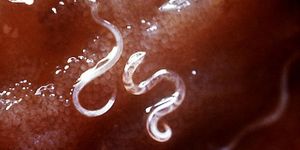Apollo 17 Moon Samples Illuminates Moon's Evolution
The Apollo Moon missions not only succeeded in landing the first humans on the surface of our nearest planetary neighbor, but were also an enormous technological and scientific triumph. Between 1969 and 1972, the six successful landings brought back 842 pounds of lunar rocks, core samples, pebbles, sand, and dust from the lunar surface, with over one-quarter (244 pounds) of those samples coming from the final mission, Apollo 17.
These returned samples have proven invaluable in helping scientists understand the Moon’s evolution and how it came to be what we see today. One of these rock samples, identified as troctolite 76535, remains one of the most scientifically valuable Moon samples due to its undefiled nature.
Understanding Our Moon’s Evolution
Using a specialized electron microscope, researchers led by University of Hawaii Manoa School of Ocean and Earth Science and Technology graduate student William Nelson, were able to perform a high-resolution analysis of troctolite 76535 and determined a rapid cooling history at no more than 20-million-years at high temperatures.
"Previous reports suggest the minerals in the Apollo 17 sample were chemically homogeneous," said Nelson. "Surprisingly, we found chemical variations within crystals of olivine and plagioclase. These heterogeneities allow us to constrain the earliest, high-temperature cooling histories of these minerals using numerical models." This means the minerals within 76535 were previously believed to be uniform, or the same, throughout the entire sample. However, this study has challenged those previous reports.
This new finding challenges the previous rapid cooling estimates of 100-million-years while also supporting initial rapid cooling of magmas within the lunar crust. Essentially, this means our Moon allegedly cooled down five times quicker than previously estimated.
Troctolite 76535
Collected as part of a rake sample at Station 6 during Apollo 17, the mineralogy of 76535 consists of olivine, pyroxene, plagioclase, augite, spinel, baddeleyite, metal, phosphate, troilite, and pyrochlore. The approximate age of 76535 ranges from 4.19 to 4.61 billion years. These approximate ages were derived using several radiogenic age dating techniques between 1975 and 1976, and then again in 1992. This most recent study has given approximate age of 4.236 billion years old, which means this sample is possibly almost as old as the Earth (4.5 billion years)!
Studying Past Lunar Samples
Along with its scientific findings, this study also demonstrated the value of re-examining previously analyzed samples using modern techniques and how quickly new data can continue to help shape our understanding of planetary evolution. This is the purpose of the Lunar Sample Laboratory Facility at NASA Johnson Space Center, which opened in 1979 and is the chief repository of the nearly 842 pounds of lunar samples collected by the Apollo missions. The facility also stores rocks, core samples, regolith, and sand and dust from Apollo and Soviet robotic Luna missions. While some of these samples have been examined, such as troctolite 76535, others remain in storage for when newer technologies emerge to help study them in greater detail.
Sources: NASA, SOEST, Troctolite 76535, Space Center Houston










